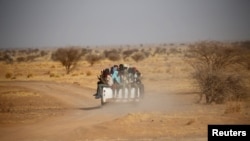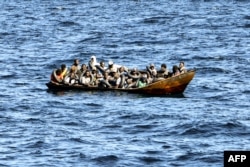Thousands of refugees and migrants who risk their lives on dangerous land routes across the African continent are subject to violence, abuse and exploitation, according to a report released Friday by the U.N. Refugee Agency, International Organization for Migration and the Mixed Migration Center research group.
The report is largely based on interviews of 32,000 refugees and migrants conducted between 2020 and 2023. The report says the number of people attempting perilous land crossings has increased, as have the protection threats they face since the first edition of the report was issued in 2020.
With more people estimated to cross the Sahara Desert than the Mediterranean Sea, the report presumes that twice as many refugees and migrants die in the desert than at sea — although the statistics in the report seemingly belie that.
“In total, 1,180 persons are known to have died while crossing the Sahara Desert for the period January 2020 to May 2024, but the number is believed to be much higher,” the report says. “During the same period, around 7,115 people were reported to have died or gone missing in the Mediterranean Sea.”
Vincent Cochetel, UNHCR special envoy for the Western and Central Mediterranean Situation, clarified the seeming discrepancy between the numbers of reported land and sea deaths, noting that, “We do not have an accurate number of statistics of people who die along the land route because there is nobody collecting the bodies.”
“We have better knowledge of shipwrecks because people are collecting the bodies when the shipwreck is close to the shore of the Mediterranean,” he told journalists in Geneva Thursday in advance of the publication of the report.
“It is not based on hard data but based on the testimony of people,” he said.
The report notes that “the eruption of new conflicts in the Sahel and Sudan, the devastating impact of climate change and new disasters and emergencies in the East and Horn of Africa are driving many more people now than in 2020 to cross Africa’s dangerous land routes in search of safety and better economic opportunities.”
Among the litany of risks and abuses reported by refugees and migrants are torture, physical violence, arbitrary detention, death, kidnapping for ransom, sexual exploitation, enslavement, human trafficking, organ removal, robbery, and collective expulsions.
In the survey of 32,000 refugees and migrants, 38% of the respondents cited physical violence as the main risk encountered during their journey. The risk of death, which was reported by 14% of the respondents in the previous report, has now increased to 20% and the risk of sexual and gender-based violence also has increased to 15% from 12.5% percent reported in 2020.
“The risk of kidnapping seems to be a new one,” Cochetel observed. “It used to be mentioned by 2% of the respondents four years ago, now it is mentioned by 18% of the respondents. Almost one out of five claim that the journey involves that risk of kidnapping.”
The report notes that across parts of the continent, refugees and migrants are increasingly encountering “insurgent groups, militias, and other criminal actors” and “where human trafficking, kidnapping for ransom, forced labor and sexual exploitation are rife.”
Cochetel said he was surprised to see that the survey respondents indicated that they did not necessarily consider smugglers and traffickers to be the main perpetrators of violence.
“We thought that they were the main troublemakers on the route,” he said. “In fact, it turns out it is more criminal gangs, that can sometimes include traffickers. But the perception by migrants and refugees, these are criminal gangs operating and it is also law enforcement authorities, non-state actors, which are normally armed groups abusing the people on the way.”
Bram Frouws, director of the Mixed Migration Center, said it was regrettable to have to produce another report that yet again presents the “unimaginable levels of violence refugees and migrants are facing on these routes. It is unacceptable. … This remains a collective stain on our conscience.”
He said all perpetrators of violence and other crimes against these vulnerable, desperate people must be held accountable “but, at the moment, much of this is happening in a situation of near complete impunity.”
“We need to stop going after the very low-level pickup drivers in Niger, for example. We should really follow the money and catch the big guys, the ones that are responsible for all this violence,” he said.
The UNHCR, IOM, partners and several governments have stepped up life-saving services and assistance for refugees and migrants traveling on the dangerous routes. But they say the humanitarian action is not enough.
The organizations are calling for more concrete measures to protect and save the lives of those embarking on dangerous journeys. They say a greater push must be made to address the root causes of displacement and drivers of irregular movements.










